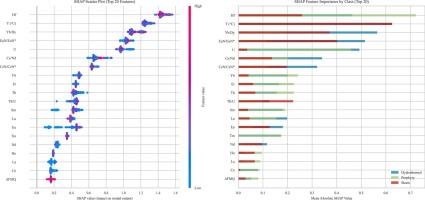Machine learning coupled with zircon trace elements revealing the diverse mineralization styles in the southern Great Xing’an range
IF 3.6
2区 地球科学
Q1 GEOLOGY
引用次数: 0
Abstract
Zircon stands out as a crucial accessory mineral in geological studies, serving as a valuable archive of isotopic and trace element information. These characteristics make zircon a widely used indicator of magma fertility and mineralization potential. Since 2011, the southern Great Xing’an Range (SGXR) has emerged as a prominent mineralization zone, leading to numerous coeval discoveries of hydrothermal-vein, porphyry, and skarn-type deposits. In this study, we analyzed 10 ore-related granites and integrated previously published data to establish a new zircon trace element database. Using low-code machine learning solutions (PyCaret), CatBoost was identified as the best classification model for distinguishing mineralization diversity. It achieved an accuracy of 0.9217, an AUC of 0.9837, and demonstrated high recall, precision, and F1-scores of 0.9217, 0.9251 and 0.9214, respectively. The top five features for identifying mineralization, based on important scores, are Hf, T(°C), U, EuN/EuN* and Yb/Dy, indicating that variations in magmatic water content, temperature, and redox conditions play a critical role in determining ore deposit types. Quantitatively, hydrothermal-vein zircons exhibit the widest temperature range (544–945 °C; mean 758 °C) and highest Hf concentrations (mean 35,855 ppm), followed by porphyry zircons with narrower temperatures (605–954 °C; mean 752 °C) and lowest Hf contents (mean 15,860 ppm), while skarn zircons show the highest mean temperatures (597–980 °C; mean 777 °C) but the intermediate Hf contents (mean 21,788 ppm). These variations reflect differences in magmatic conditions, degrees of fractionation, and fluid–rock interaction among mineralization styles, and are further influenced by broader geological factors such as metal-enriched sedimentary strata, magmatic evolution, and tectonic setting. Integrating zircon geochemistry with regional geological context enhances our understanding of ore-forming processes and supports exploration in the SGXR.

机器学习与锆石微量元素结合揭示了大兴安岭南部不同的成矿风格
锆石在地质研究中是一种重要的辅助矿物,是一种有价值的同位素和微量元素信息档案。这些特征使锆石成为广泛使用的岩浆富集度和成矿潜力指标。2011年以来,大兴安岭南段成为突出的成矿带,同期发现了大量热液脉型、斑岩型和矽卡岩型矿床。本文对10种与矿石相关的花岗岩进行了分析,并综合前人发表的资料,建立了新的锆石微量元素数据库。使用低代码机器学习解决方案(PyCaret), CatBoost被确定为区分矿化多样性的最佳分类模型。准确率为0.9217,AUC为0.9837,查全率、查准率和f1得分分别为0.9217、0.9251和0.9214。Hf、T(°C)、U、EuN/EuN*和Yb/Dy是成矿识别的前5位特征,表明岩浆水含量、温度和氧化还原条件的变化对矿床类型的确定起着关键作用。从数量上看,热液脉状锆石的温度范围最宽(544 ~ 945℃,平均758℃),Hf浓度最高(平均35855 ppm),其次是温度较窄的斑岩锆石(605 ~ 954℃,平均752℃),Hf含量最低(平均15860 ppm),矽卡岩锆石的平均温度最高(597 ~ 980℃,平均777℃),但Hf含量居中(平均21788 ppm)。这些变化反映了成矿类型之间岩浆条件、分馏程度和流体-岩石相互作用的差异,并进一步受到富金属沉积地层、岩浆演化和构造背景等更广泛的地质因素的影响。将锆石地球化学与区域地质背景相结合,有助于认识成矿过程,为SGXR的找矿提供依据。
本文章由计算机程序翻译,如有差异,请以英文原文为准。
求助全文
约1分钟内获得全文
求助全文
来源期刊

Ore Geology Reviews
地学-地质学
CiteScore
6.50
自引率
27.30%
发文量
546
审稿时长
22.9 weeks
期刊介绍:
Ore Geology Reviews aims to familiarize all earth scientists with recent advances in a number of interconnected disciplines related to the study of, and search for, ore deposits. The reviews range from brief to longer contributions, but the journal preferentially publishes manuscripts that fill the niche between the commonly shorter journal articles and the comprehensive book coverages, and thus has a special appeal to many authors and readers.
 求助内容:
求助内容: 应助结果提醒方式:
应助结果提醒方式:


